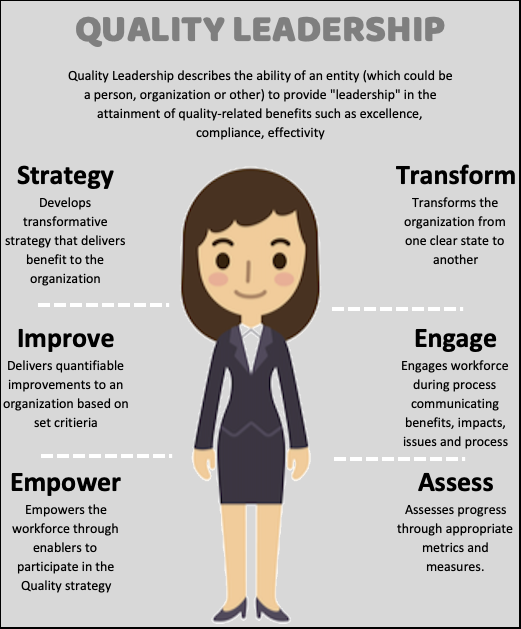
Quality Leadership describes the ability of an entity (which could be a person, organization or other) to provide “leadership” in the attainment of quality-related benefits such as excellence, compliance, effectivity etc.
As with traditional leadership, Quality Leadership includes a variety of topics; these include
- Strategy
- Goal Setting
- Planning
- Employee development.
While there are similarities, Quality Leadership is distinct from traditional leadership. One of those key differences is the significance of strategy in the execution of the role. This is coupled with the influence of quality across the organization, which might be at odds with other functional leaders responsibilities, which may be more stovepiped.
In today’s article, we’ll be trying to answer what is Quality leadership we’ll be covering
- What is Quality Leadership
- Problems with Quality Leadership
- Selecting a Quality strategy
- The role of empowerment in Quality Leadership
- Quality Leadership for the worker
What is quality Leadership?
Leadership is a widely used term within a business context and can be understood in a number of ways.
One of the challenges in defining leadership is that it is so far-reaching.
Let’s take a look at typical core skills of leadership:
- Strategic Thinking
- Change Management
- Delivering on strategy
- Managing people
- Influence
- Communication
- Managing change
So is there a difference between common leadership tasks and Quality Leadership tasks?
Quality is a transformative process, one that takes a business and changes it to meet a goal or objective.
Quality, therefore, requires transformative leadership.

We can argue that this requires specific skills above and beyond those of traditional leadership; these skills include:
- A general ability to deliver quantifiable improvements against a given baseline
- The ability to develop a transformative strategy
- Change management skills
- The ability to engage and communicate effectively about change with members of the organization
- An understanding of and an ability to deliver compliance that relates to the whole organization
- The ability to influence
- The ability to empower others to participate in delivering a strategy
- The ability to solve complex organizational problems
- The ability to foster change.
- To develop systems and processes that create an environment where innovation is accepted and rewarded.
As we describe, what is key here is that, unlike many other leadership roles, Quality has a responsibility to the whole organization and rather than be centred on performance, it also embraces change.
It is also evident that it is not enough for those in the position of quality leader to do the work themselves.
Quality leadership requires the ability to engage employees in the process of improvement and motivate them to undertake the work because it matters to them.
This latter part requires workers to engage with the expected benefits of the quality strategy.
Quality Leadership then requires the engagement of the whole organization in the task.
Problems with Quality Leadership
Much like traditional leadership, quality leadership is open to challenges and issues. Through understanding these, we can also shed light on the role and expectations.
Common problems include:
- Strategy & Vision are inappropriate and don’t drive quality
- The management system does not support change management
- Employees are not engaged and fail to see the benefits of the strategy, so they do not participate
- Leaders don’t engage the whole system, but only a part of it
- Change is focussed on short term goals and forgoes long term planning
- Enablers (such as skills and tools) are not present
- Requirements are not understood, and compliance is not achieved
Many of these challenges are similar to those you’d expect to face in other leadership positions. However, once again, the impact on them is more severe than in a functional silo with the whole organization affected.
Selecting a Quality strategy
As we can see, strategy and vision are key elements of Quality leadership.
Given this, what are the key enablers to ensure we select an appropriate strategy?
https://blog.lnsresearch.com/5-elements-in-building-an-effective-quality-strategy has an excellent piece on the key five elements for driving a Quality Strategy. it surmises that there are five key parts to this
- Expectation management, being clear on what the journey is – how long it will take and what good will look like
- Quality aligns itself with the objectives of the organization
- Goal setting is long term
- Project mobilization is near term
- It utilizes metrics to inform
So what can we learn from these? These tell us that Quality is not a “get rich quick scheme” and that quality is not divorced from the organisation’s goals.
Driving Quality, obtaining results and instilling a continuous improvement philosophy takes time to get right.
The role of empowerment in Quality Leadership
Perhaps the true deliverable of quality leadership is the empowerment of the organization.
Moving beyond TQM, employees need to be wedded to the idea that quality must be at the heart of all actions.
This does not happen without sustained empowerment.
As a result, one of the principal tasks of Quality Leadership must be to develop channels of delivering empowerment to the workforce in order that they can deliver quality.
So how do we deliver empowerment?
Empowerment usually comes from the following aspects
- Employees are engaged with strategy
- Provision of appropriate skills and tools
- Communication
- Motivation
- Development of people
Quality Leadership for the worker
One way of understanding the success of Quality Leadership is to consider its impact on the everyday worker within the organization.
Engagement with the workforce is a key aspect of understanding whether leadership is successful or not.
We can ascertain this by asking a series of relatively simple questions.
- Are employees aware of the quality strategy?
- Do they see quality as compliance or something different?
- Do they fully understand associated values and expectations?
- Is quality “done to them,” or are they engaged in the process
- How do they rate communication
- How are they engaged in delivery?
- Does the QMS help or hinder?
This list implies feedback, and as ever, sometimes that feedback may not be what the business wants to hear.
As we discussed earlier in this article, the role of quality leadership is to enable an organization and help them achieve the quality strategy.
However, if quality leadership is to be effective, it is that feedback that is crucial in understanding whether processes are enabling or hindering.
Where it is hindering an organization, it’s essential to listen to the organization and consider what needs to be done to remedy the situation.
As ever, some of the rudimentary aspects of leadership (not just quality leadership) are important today as they ever have.
Summary
In this article, we’ve looked at the function of quality leadership.
We’ve assessed what it sets out to achieve, how it goes about it and what key challenges it faces.
Effective quality leadership (whether that’s a quality director at the top of the wider team) succeeds by influencing and empowering the organization to deliver quality and compliance.
There is clearly more at play than just these traditional aspects; quality leadership has a key part to play in organizational effectiveness and competitiveness.
How does your organization approach quality leadership? Has it got particular strategies or maybe specific problem areas that you would like to share with our readers?
As ever, we’d love to hear from you – you can reach us via the comments section below or via Twitter at the usual address.
